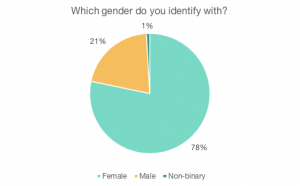Imbalances in mental health research samples are a key area of work in this day and age. This article highlights the need to improve engagement for men, exploring the reasoning behind inter-gender differences in participation and the great need for righting this.
Written by Babak Saghari, Neuroscience Graduate.
In such unprecedented times of change and uncertainty, it is important to study the effects of the pandemic on the mental and physical health of the population. However, in order for such research to be helpful, it fundamentally requires data to be collected from a wide demographic. This includes representation of all genders, cultures, socioeconomic backgrounds and health statuses. One group that is often underrepresented, if not absent in research, are men. In this blog, we focus on the importance of the male voice in mental health research and hope to increase the recruitment of men into the RAMP study and wider psychological research.
We know that men are less likely to seek and receive treatment for mental health problems than women, and there are many reasons why this might be. For example, traditionally defined masculine traits such as self-reliance have been associated with reluctance to seek help. Traditional methods of diagnosis and symptom measurement have been unable to clearly capture diagnoses in men, particularly due to the lack of data and recruitment of men in these studies. To better understand the symptoms and outcomes specific to the individual, it is therefore vital for more men to participate in research. This will then facilitate the development of better screening tools and treatments strategies – for example – those which account for masculine traits and the male experience.
We also know that there is greater perceived stigma surrounding the male voice in mental health, further contributing to the reluctance to seek treatment in men. Research shows that although the prevalence of common mental health problems is higher in women, the majority of in-patient admissions due to a mental health condition are men. This not only reiterates that men are less likely to reach out for help until their condition has worsened, but also supports research which shows men more often report self-medicating with alcohol and or/ illegal substances to cope with their symptoms. Understanding these differences in coping mechanisms can help researchers to develop more tailored and effective therapies for both men and women. This is critical work, as the devastating consequences of untreated mental health are in plain sight.
“Suicide is the leading cause of death in men under the age of 45 and 4 in 5 suicides are by men”
Furthermore, men make up the majority of the homeless population and prison system, many of whom suffer from mental health problems. These are just some reasons why it is critical to understand why such disparities exist and to guide future treatments in accounting for gender differences within the population.
It is not yet known what effects the pandemic will have on the mental and physical health of individuals in the population. To understand how such unprecedented circumstances affect the wider population, as well as specific subgroups, we need a more balanced representation. The only way we can make sure that any insights garnered from our research are generalisable and benefit all members of the population is by making sure that study participants are representative. Preliminary data from the RAMP study is already showing that men are vastly underrepresented.
If you are passionate about improving the mental health and well being of the population, across all age groups, genders and cultures, take part in our research study – and tell your dad, brother, uncle, nephew and friends, to take part as well – it’s important for now and for generations to come. These studies can pave the way towards better understanding the vast differences individuals have in coping with dramatic changes to their life, both due to the pandemic and of societal pressures placed on men and women. By identifying who is at greater risk of experiencing mental distress, and the lifestyle and home factors that may help to mitigate symptoms of a mental health condition, research can ensure that treatments and resources are more effective and available in the future.
Thank you for your interest, and please spread the word!
References
NHS England » Tackling men’s mental health is the lynchpin to suicide prevention (no date). Available at: https://www.england.nhs.uk/blog/tackling-mens-mental-health-is-the-lynchpin-to-suicide-prevention/
Prevalence of mental health issues within the student-aged population – Education Policy Institute (no date). Available at: https://epi.org.uk/publications-and-research/prevalence-of-mental-health-issues-within-the-student-aged-population/
Smith, D. T., Mouzon, D. M. and Elliott, M. (2018) ‘Reviewing the Assumptions About Men’s Mental Health: An Exploration of the Gender Binary’, American Journal of Men’s Health. SAGE Publications Inc., 12(1), pp. 78–89. https://journals.sagepub.com/doi/full/10.1177/1557988316630953


